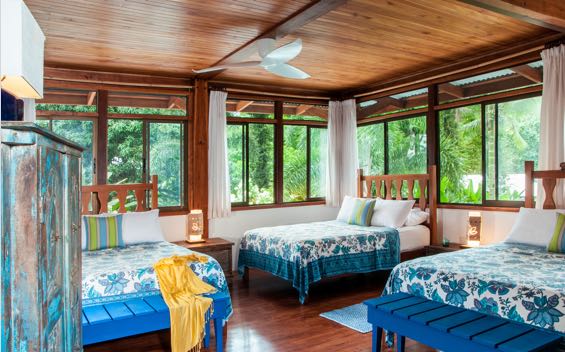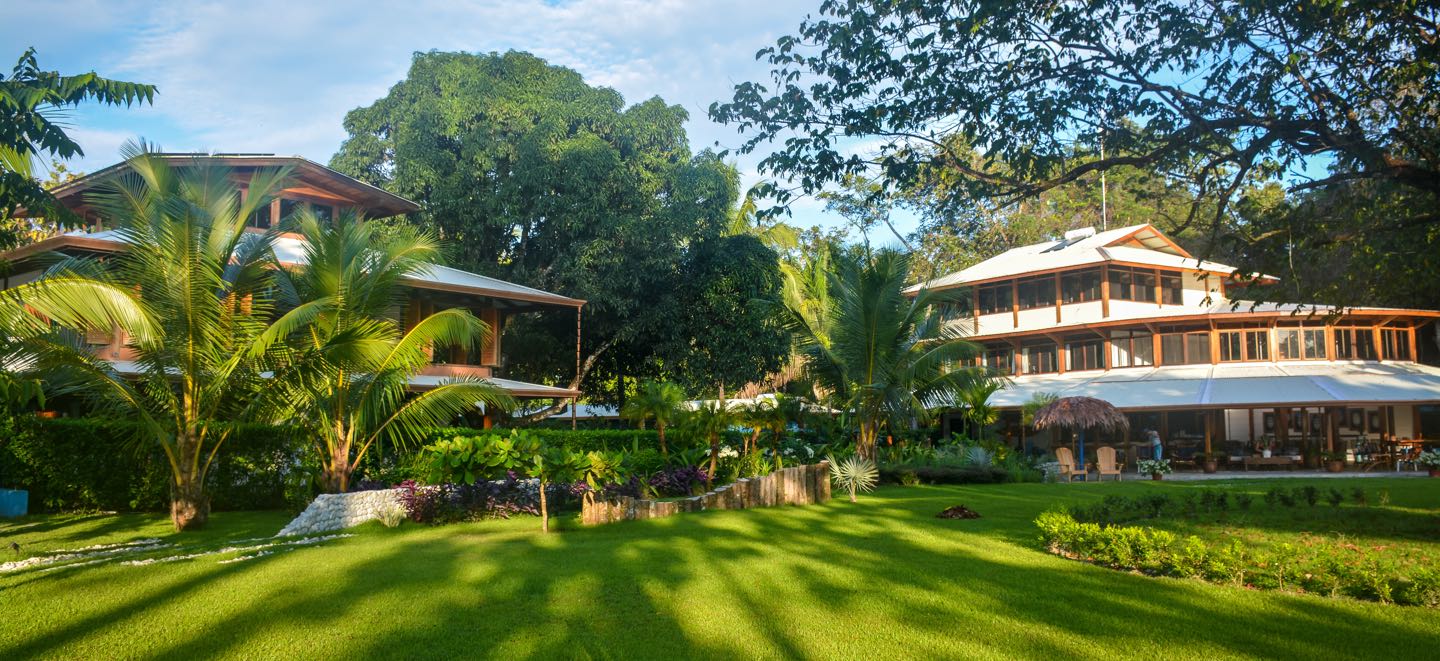
Preparing for Travel
Do I need a passport or a visa to travel to Costa Rica?
As of December 31, 2002 all Canadian, US and EU citizens who travel to Costa Rica for tourism and pleasure purposes need a valid passport. Please check your passport to make sure you have at least 6 months validity from the time you enter Costa Rica. If not, you should get a new passport before traveling. A visa is not required.
How long is the flight from San Jose to Puerto Jimenez?
The most direct route to Puerto Jimenez from San Jose is to use one of the trusted air-carriers Costa Rica has to offer.
These air-carriers offer numerous flights from San Jose to Puerto Jimenez daily, with the one-way trip taking approximately 40 minutes.
It should be noted, however, that there are no late afternoon or evening flights with either air-carrier. The last flight into Jimenez is at approximately 3 in the afternoon in the high season. In the green season, the final flight is usually around 12/1 pm. Visitors arriving into the country in the late afternoon or evening should take this into consideration.
What should I pack?
Check out this article for our suggestions on what to pack for your trip to Blue Osa. Additionally, keep these things in mind as you select what items to bring:
• We are in the jungle/rainforest — expect humidity and frequent rain if you visit during the green season.
• The Osa Peninsula is characterized by warm, breezy days, with highs between 82 and 92 degrees, and lows in the range of 70-80.
• Wet items can take longer than expected to dry, especially during the green season and/or if the sky is overcast (we do offer laundry service for a fee of $29/load if you need to have your clothes washed and dried).
• Blue Osa offers a guest drying area for clothes and towels.
• Moisture-wicking clothes will dry the quickest and will keep you coolest during our hot, sunny days.
• If you plan to go on excursions, it is recommended to bring shoes that you don’t mind getting wet and that have a good grip. A waterproof or dry bag can also be helpful if you wish to bring your phone/camera along with you while out exploring.
• We do have ants, mosquitos, and other small bugs that can occasionally be an annoyance — pack bug spray!
• We have a small store on-site with some essentials available to purchase and there is a grocery store and pharmacy in town where you can find anything you forgot to pack.
• Blue Osa DOES provide soap, shampoo, towels for the beach and shower + bed sheets. You do not need to bring these items.
Do NOT Bring
• We do not allow hair dryers, flat irons, etc. We are an OFF-Grid resort and do not have the energy to provide energy to these devices. Using these devices will cause damage to our sensitive system. (If you are interested in learning more, please click here.)
• Snacks that are left out in the open. Any food you bring will attract animals. If you do bring any snacks, please double bag it in ziplocks.
Do I need any shots before visiting Costa Rica?
You do not need any shots or vaccines before visiting Costa Rica. However, we always suggest speaking with your Doctor and referring to the World Health Organization’s website before traveling.
Should I drive to Blue Osa from San Jose?
Driving to Blue Osa from San Jose is a beautiful way to view and experience the beautiful Costa Rica countryside.
With the use of Waze or Google Maps, navigation is easy.
The drive takes about five to seven hours. We highly recommend it.
How much baggage can I bring?
This depends upon the carrier you fly. The general rule is a 30-pound baggage limit enforced on the “in-country” flight to/from Blue Osa. Baggage over 30 pounds will incur a surcharge, so pack light! Besides, how much clothing does a person really need in the tropics?
If you need more clarity, please double-check with airlines to find out exactly how much weight your baggage can be.
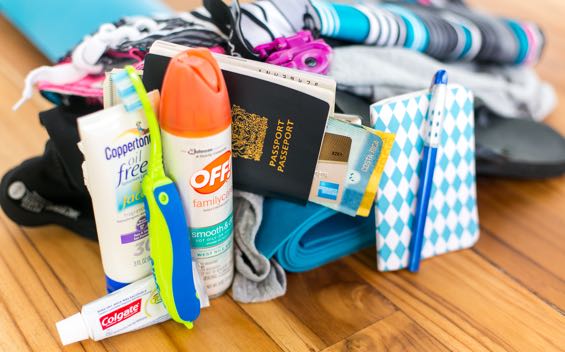
Safety
Is Costa Rica safe?
Generally, Costa Rica is quite safe. Like any place, normal precautions and care should be taken depending upon where you are visiting.
Violent crime is rare in Costa Rica. Petty crime tends to be more common.
Big cities, or beach resort areas and any place with a concentration of tourists is more likely to draw thieves and such.
Since Blue Osa is located in the middle of the rainforest, we are lucky that we don’t have encounters like this.
Is Blue Osa safe for a single woman to visit?
Yes, our property is very secure.
Blue Osa is a remote jungle beach paradise. Often you will not see anyone on our beach. At night we have watchmen. And a safe in your room to protect your valuables.
Are there bugs or mosquitos?
We do not have problems with mosquitos here at Blue Osa. Since we are located on the beach, we enjoy a lot of sea breezes. There are no concerns about malaria or other diseases on the Osa.
What happens in the case of a medical emergency in the middle of the rainforest?
There is a 24-hour medical clinic located in Puerto Jimenez, only 20 minutes away from Blue Osa. Additionally, Puerto Jimenez has a 24-hour flight service that transports patients to the nearby hospital in Golfito (an eight-minute flight) or to San Jose (a forty-minute flight).
Medical care standards in Costa Rica are high. They are considered to be the best in Central America. San Jose, particularly, has excellent hospitals, medical facilities, and doctors that attend almost exclusively to foreign residents and travelers.
Our emergency contact information is [email protected]. We do not have a phone number to be reached at. We check our email regularly.
Is the drinking water safe?
Our water is constantrly tested to ensure your safety. Additionally, we provide filtered water in the dining area. As we do not allow open cups on our yoga deck, we do invite our guests to bring a water bottle, or they may purchase one in the Blue Osa store.
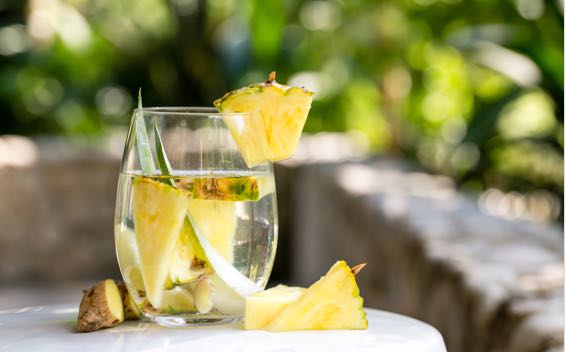
Location - Osa Peninsula
What is the eco-tourism? What is an eco-resort?
Ecotourism is responsible travel to natural places. A commitment to conserving the environment and to the sustainability of the well-being of the local people.
Blue Osa practices sustainable tourism through recycling, water conservation, low impact tourism, organic gardening and education to our guests through awareness on and off the property.
We ask all guests who come to visit Blue Osa and the Osa Peninsula to help us keep this beautiful environment pristine.
Is Blue Osa near the ocean?
Blue Osa is situated right on the beach, with tropical rainforest surrounding us on every other side. The beach is a 30-second walk from Blue Osa. This makes it easy for guests to wake up in the morning at sunrise and stroll down to the ocean for a morning swim as the jungle awakens.
Can I swim in the ocean? What is the ocean and beach like?
The beach is usually quite deserted, very scenic, and serene, providing opportunities for walks and exploration. There are no rip tides or undercurrents, which makes for some comfortable swimming.
We do not have any lifeguards on the beach.
Can I sunbathe nude on your beach?
The beach is tranquil and typically deserted. You will see the occasional fisherman or family strolling by, usually on Sundays or holidays. If you do decide to sunbathe nude, we ask that you be sensitive to anyone that walks by. Please respect the local Catholic customs of the country. We invite any guests wanting to sunbathe nude to practice “conscious nudity.”
Can I surf?
We have world-class surfing right in front our property. In town you may rent a surf board and bring it to Blue Osa and from here, explore. We can even arrange for you to take surf lessons if you interested in learning.
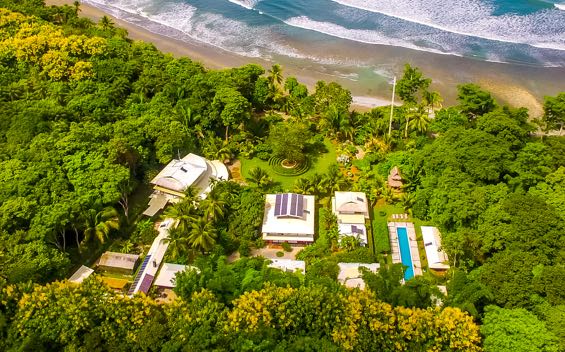
Weather
What is the weather like in Costa Rica?
Costa Rica is a tropical country located between 8 and 11 degrees north of the equator. It has twelve micro-climates, three different rainfall regimes, and many microclimates.
Costa Rica has a stable climate year round.
There are two well-defined seasons: the green season (Invierno) and the dry/summer season (Verano). The one main difference is rainfall averages.
The dry season runs from December to April and the green season from May to November. Rainfall averages for the country may reach the highest point during the months of September and October — approximately 650 mm per month. Seasonal changes don’t bring significant changes in temperatures. Although the nights may be fresher in some areas during the rainy season. Mornings are usually sunny all year round.
What is the weather like at Blue Osa?
The Osa Peninsula (where Blue Osa is located) is characterized by warm, breezy days, with highs between 82 – 92 degrees, and lows in the range of 75 – 85. Please take note, however, that the Osa Peninsula IS part of the rainforest, and is surrounded by jungle.
See our weather report here.
The Weather.com or Google report told me to expect rain?
We strongly encourage you NOT to check the weather report for Blue Osa (or Costa Rica for that matter) on the internet. It is usually wrong and does not give an accurate picture of what to expect.
Furthermore, as we have said in the other FAQ answers, Blue Osa is in its own microclimate, and there is no accurate reporting on what to expect.
Seriously, we are not kidding.
If you need some historical reference, please see our weather report page.
When is the best time to come to Blue Osa? When is the green season?
Because the Osa Peninsula is blessed with fantastic weather year-round, there really isn’t a “best” time to visit. Most guidebooks list the ideal time to travel to Costa Rica as December through May. However, we enjoy a stable climate of 75-85 degrees relatively year-round.
Of course, don’t try looking for that information via online weather reports. Our private oasis is so off the map, Google has yet to find us. FUN FACT: The 19,730 miles (about the size of West Virginia) that make up Costa Rica actually house 20 different climate zones! The bottom line?
The time to visit is whenever you want! Take a moment to check out our weekly weather report and see for yourself!
What are the different seasons?
When is the best time to visit South Pacific Costa Rica? Each month is exceptional in its own way. Here’s what you can expect when you visit:
December marks the beginning of the tourist season in Costa Rica. The temperature is nearly perfect, and everything is green and vibrant from the refreshing rains in September, October, and November. As a transitional month, December involves some rain (although lately with climate change, we have had almost no rain in December over the past few years). Visit during the first couple of weeks when there are fewer people but all of the benefits.
Average High Temperature: 28°C/82°F
January through April is summertime in Costa Rica.
Average High Temperature: 30°C/86°F
May and June transitions South Pacific Costa Rica from the dry season to the green season. The weather changes, and we are blessed with the occasional 20-minute cooling shower in the days. The moisture cools the air, creating comfortable temperatures. Everything’s bigger in May and June. Waves are larger for surfing; orchids are at their peak; sail fishing starts, and sport fishing gains traction. Now the rivers are really flowing, so it’s a great time for whitewater rafting and waterfall rappelling. Fewer people visit Costa Rica during this time, so you can avoid crowds.
Average High Temperature: 28°C/82°F
July and August and even September are the best-kept secrets in South Pacific Costa Rica. Warm, sunny mornings and rain-cooled evenings are a welcome break from summer in the United States and Southern Europe. This is also a popular time for Costa Ricans to vacation in the South Pacific region, and it’s your opportunity to mix with the locals. July marks the start of sea turtle season—which spans from July to December—and the region’s Tortuga Beach is one of their favorite nesting spots. You may experience the unexpected pleasure of witnessing a baby turtle release.
You may also enjoy the possibility of seeing Humpbacks up really close.
Average High Temperature: 28°C/82°F
October is a little rainier but still very pleasant. With more torrential rainfalls at night, the mornings in the afternoons are often filled with beautiful crips, clear skies leading us into a beautiful, refreshing rain in the late afternoon. Some of us foreign locals take great pleasure in being here during October due to the lack of tourists and crowds. It is one of the best times for whitewater rafting, river and waterfall swimming, and sea turtle viewing. This time is ideal for spotting other animals as well. The animals descend the mountains to take advantage of the fresh vegetation. You can see monkeys, sloths, frogs, coatis, butterflies, and tons of birds.
Average High Temperature: 28°C/82°F
November starts the transition from the rainy months. Everything is lush and green. There is still some rainfall, but it is less than half the average rainfall in October. The last couple of weeks of November are a great time to visit Costa Rica. The waves are moderate, sport fishing is good, and the beaches are breathtaking.
Average High Temperature: 28°C/82°F
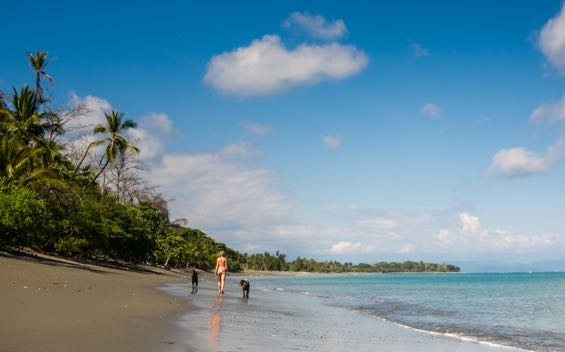
Reservations
How early do I need to book the space at Blue Osa?
Rooms here at Blue Osa tend to fill up two to six months in advance, sometimes even earlier. If you know the dates you would like to stay at Blue Osa, inquire now to ensure space availability. Make your reservation as soon as possible to guarantee the dates you want.
We would like all our prospective guests and clients to know that we do not recommend staying for less than five nights here if you are leaving or arriving by plane.
From our experience, a minimum of five nights is needed to experience all that there is to do and see while staying at Blue Osa.
Do you accept large groups?
Yes we do. Please email us and tell us about the nature of your group and how many people you would like to bring, and when. We offer a special discount to those who would like to bring a group of 10 or more and can happily send you our group information package.
What time is check-in and check-out?
Check-in time is 2:00 PM.
Check-out time is 10:00 AM.
All services at Blue Osa are not available on the day of check-in or check-out. This includes yoga classes, spa services, bar/juice services, etc. This includes yoga classes, spa services, bar/juice services, etc. For guests leaving later than 10:00 AM, or arriving earlier than 2:00 PM, we are more than happy to keep your luggage secure and safe for you as you wait for your room to be ready.
Being an all-inclusive retreat, Meals included in your stay: Dinner on the day of arrival; breakfast, lunch, and dinner on each full day; and breakfast on the day of departure.
Mealtimes are typically
7:30 breakfast
12:30 lunch
6:30 dinner
Our kitchen is not available for special meals.
Which credit cards and debit cards are accepted?
Visa and Mastercard are accepted at Blue Osa.
Should you require cash, the Banco Nacional (BN) and Banco de Costa Rica (BCR) in Puerto Jimenez do have ATM cash machines. However, we suggest bringing whatever money you need with you, as all of our rooms are equipped with secure safes for your valuables. Canadians or internationals should also be aware that the ATM at the Banco Nacional in Jimenez sometimes does not recognize international debit cards.
Please be aware that we ONLY accept cash TIPS. It is not possible to use your credit card for cash TIPS.
Do you accept US dollars?
Yes, we accept U.S. Dollars. We do not accept any other cash currency at Blue Osa.
What are your cancellations and refunds policy?
Any and all deposits or payments made to hold reservations are non-refundable and non-transferable.
Any deposits or full payments made for specific retreats or events are non-refundable and non-transferable.
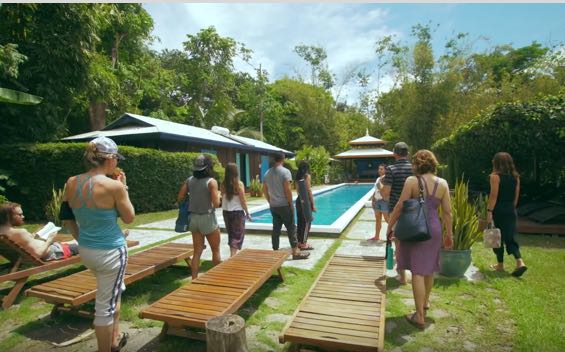
Tipping
Do I need to TIP?
Tips for services rendered are very much appreciated by Blue Osa’s hardworking staff. At the end of the week, you may leave a cash tip in our tip box. All tips will be pooled and divided evenly among our staff of about 21 people who work in the kitchen, garden, office, and housekeeping staff. If you would like to tip individually, you may do that also at check-out.
As a guide, may we suggest a tip of $20 -$40/day. So if your stay is for one week, a suggested tip amount would be $140 to $280. Please note that we only accept cash tips. We are unable to process tips through your credit card.
Likewise, tips for individually booked spa treatments and eco-tours are left to your discretion.
Can I leave a TIP with my credit card?
Please note that we only accept cash tips. We are unable to process tips through you credit card. We do suggest bringing enough cash for any tips, or extra services/shopping you may do outside of Blue Osa.
How much cash should I bring?
Because we do not accept credit cards for tips, we do encourage you to bring some cash with you. We do occasionally have outside vendors come for a famers market at Blue Osa, and there are others in the area. Our suggested cash amount is $250 to $500 for the week.
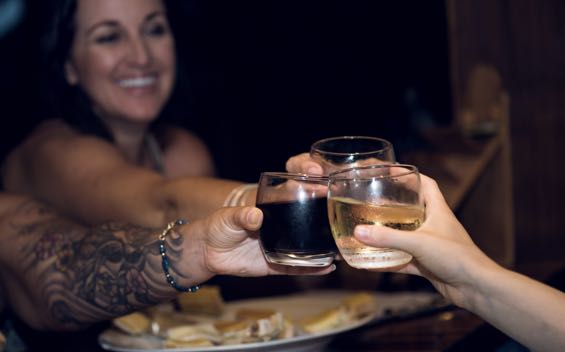
Others
Is there air conditioning at Blue Osa?
We are a low-impact beachfront eco-hotel. Blue Osa works rigorously to reduce our carbon footprint and impact on the surrounding environment. Thus, each of our rooms is equipped with a ceiling fan. The architectural design of Blue Osa allows for the constant flow of air through screen walls, creating a fresh and breezy environment.
To help some of our guests adjust to this tropical environment, four of our rooms offer air conditioning – Om, Karma, Balance, and Namaste.
For our other rooms that do not offer AC, we have found that the vast majority of our guests are always quite comfortable.
How do I request a shuttle?
• Please Contact Us to arrange a Blue Osa shuttle to and from the Puerto Jimenez Airport. Include your full name, arrival, and departure times on Nature Air or Sansa.
• If you are visiting Blue Osa with a group retreat, give this information to your group leader to schedule with Blue Osa as soon as it’s available.
• Once the shuttle request form is received by us, a shuttle confirmation will be emailed to you.
How much money should I convert to local currency?
We suggest NOT converting ANY money!
It is not necessary to convert any money to local currency (colones) as all businesses happily accept U.S. dollars (however, expect your change to be in colones).
We do suggest bringing many small bills so you do not have to receive any change in colones. The current rate of exchange fluctuates and is around 600 colones for every 1 US dollar.
Do you have a gift shop?
We have a gift shop available, providing yoga clothes, t-shirts, local artwork and jewelry, suntan lotion, bug repellant, etc. Additionally, during our high season or when we have large groups, Blue Osa will typically host a “Farmers Market” for our guests.
Do you have yoga mats available?
Yes we have yoga mats available.
Our yoga studio is fully equipped with yoga props: chairs, blankets, sandbags and blocks.
Are children allowed at Blue Osa?
We do allow children. But only during these activities:
1. During yoga teacher trainings immersions with Yogi Aaron, he does allow mothers to bring their children during the training. Please do keep in mind that we do not have any babysitting services on property or children’s day-care. Nor do we provide for them.
2. During group retreats, you may bring your children with permission from the group leader of that retreat.
Do you have internet or phone access? Do you provide computers?
Blue Osa offers a free WiFi service. This service is available in the main lounge area as well as the dining area. Since we practice mindfulness and silence in the mornings, the internet is turned off until 7:30 am.
The internet is also turned off again at dinner from 6:30 until 7:15 pm. We do not have any computers available for use.
While there are no phones in the rooms, guests are more than welcome to make calls at our office. The fee for this service is $2.00/min
International cell phone service here on the Osa can be sketchy, at best. Sometimes some phones will work, sometimes they won’t. We suggest you check with your service provider and ask them specifically about service in Costa Rica.
We do invite you to leave your cell phones and laptops at home and “unplug” from your life while you are on your vacation or retreat. We suggest you take full advantage of this remote paradise to concentrate on the peace and wilderness experience.
Come to disconnect and decompress!
What is the “Osa” in Blue Osa?
The “Osa” comes from the name of the Peninsula where we are located- the Osa Peninsula. Osa in Spanish means “female bear.”
What does the phrase “pura vida” mean?
Pura Vida (POO-rah VEE-dah), used by Costa Ricans since 1956, literally translated means “Pure Life.” Contextually, it means “full of life,” “purified life,” “this is living!” “going great” It is used as a greeting, a farewell, and to express satisfaction.
The phrase has become widely known in the United States and Europe. Some foreigners view the phrase as an expression of a leisurely lifestyle, and a disregard for time. However, Costa Ricans use the phrase to express a philosophy of strong community, perseverance, good spirits, enjoying life slowly and celebrating good fortune, whether small or large.
Pura Vida also means “I am doing alright”, “I am doing perfect” and “thank you”.
Expats who adopt the expression properly get a big smile in return. It is an acknowledgment of the Costa Rican attitude towards life.
The Hawaiian equivalent of Pura Vida is “Aloha!”
Is there a laundry service at Blue Osa?
Laundry service is available at Blue Osa. The cost for this service is $29/load. Please expect your laundry to be returned within 24 – 48 hours.
What kind of food is served?
We are committed to reducing our carbon footprint and supporting local farmers. With this in mind, Blue Osa offers a variety of fresh, farm-to-table vegan/vegetarian meals.
Our typical healthy and delicious Blue Osa cuisine sample menu can be found here.
In catering to the needs of a variety of guests, we do offer eggs for breakfast as well as animal protein three times per week, as well as some recipes with
Blue Osa has a skilled, local culinary team that uses seasonal ingredients to offer a wide assortment of dishes, including traditional and international fare.
Please note that while we do our best to accommodate the individual needs of our guests (including gluten-free options), we cannot customize individual meal requests or Kosher options. Additionally, we are not gluten, dairy, or nut-free kitchen.
Finally, while our portion sizes are large, if you’re concerned about being hungry, we would encourage you to purchase extra snacks for your stay.
Additional Details About Meals:
• We offer mostly vegan/vegetarian meals, but we do serve chicken 3 times/week and eggs at most breakfasts.
• We ask you to clear your own plates and dispose of any leftover food into the labeled compost bin.
• If you are going on an excursion and/or receiving a spa treatment and will not be on time for one of your meals, let our front desk manager know and our kitchen staff will hold your plate for you.
• Coffee, tea, purified water, and snacks (apples, bananas, and house-made breads) are available for free all day long.
• Our Buddha Bar offers smoothies, fresh juices, kombucha, soda, beer, wine, and cocktails for a fee (charged directly to your room).
Is alcohol served at Blue Osa?
Because of the difficulties in maintaining a minibar service at Blue Osa, we cannot provide for the consumption of outside food, drinks, or alcohol.
Our bar is open throughout the day, and we offer a selection of beer and wine and refreshing specialty drinks.
Please remember that we are in the jungle and that open bottles of alcohol and packages of food will attract unwanted visitors to your room. These include snakes, ants, and pizotes (no kidding!). If you still choose to consume privately bought alcohol, please do so in the privacy of your room or on the beach. We do not allow privately bought alcohol in the dining room or at the pool. We thank you for your understanding and compliance.
What room amenities are not provided for?
At Blue Osa, we focus on rest & relaxation and peace & tranquility; by communing with nature and getting back in touch with one’s inner self.
For this reason, we do not have TVs at Blue Osa.
As we are an eco-resort and are operated by solar power, hairdryers are NOT allowed at Blue Osa.
Blue Osa does have standard North American power outlets, so you may recharge your camera battery, etc.
Four of our rooms offer air conditioning – Om, Karma, Harmony, and Namaste.
I do not practice yoga. Will I be welcome?
Everyone is welcome at Blue Osa. Additionally, there are many ways to practice yoga. Quietly sitting on a chair watching the morning sunrise in silence is a form of yoga practice.
